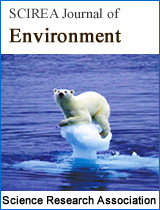Statistical Analysis And Modeling Of The Atmospheric Carbon Dioxide In The Middle East And Comparisons With USA, EU And South Korea
DOI: 380 Downloads 15436 Views
Author(s)
Abstract
Global warming is considered one of the important issues facing our planet. Global warming is the increase in average global temperatures caused mostly by increases in Carbon Dioxide CO_2. During the last two decades, the CO_2 emission in the Middle Eastern countries increased by over 200% based on The Energy Information Administration (EIA). Thus, the aim of this study is to structure a good statistical model for atmospheric CO_2 in the Middle East to identify significant attributable variables that produce the CO_2 emissions. Fossil fuel burning (gas fuel, liquid fuel, and solid fuel) cement manufacture, and gas flaring and their interactions have been identified and ranked based on their percentage of contribution to CO_2 in the atmosphere. Finally, the results of this modeling are compared to the results of the United States, European Union, and South Korea.
Keywords
Global warming, Middle East, Climate changes, Carbon Dioxide, CO_2 emission, Fossil fuels
Cite this paper
Maryam I. Habadi, Chris. P. Tsokos,
Statistical Analysis And Modeling Of The Atmospheric Carbon Dioxide In The Middle East And Comparisons With USA, EU And South Korea
, SCIREA Journal of Environment.
Volume 1, Issue 2, December 2016 | PP. 32-47.
References
| [ 1 ] | Al-mulali, U. (2012). Factors affecting CO 2 emission in the Middle East: a panel data analysis. Energy, 44(1), 564-569. |
| [ 2 ] | Boden, T.A., Marland, G., & Andres, R.J. (2011). Global, regional, and national fossil-fuel CO2 emissions. Carbon Dioxide Information Analysis Center, Oak Ridge National Laboratory, U.S. Department of Energy, Oak Ridge, Tenn., U.S.A. doi 10.3334/CDIAC/00001_V2011 |
| [ 3 ] | Tans, P. P., & Conway, T. J. (2005). Monthly atmospheric CO2 mixing ratios from the NOAA CMDL carbon cycle cooperative global air sampling network, 1968–2002. Trends: A Compendium of Data on Global Change. |
| [ 4 ] | Farhani, S., & Ben Rejeb, J. (2012). Energy consumption, economic growth and CO2 emissions: Evidence from panel data for MENA region. International Journal of Energy Economics and Policy, 2(2), 71-81. |
| [ 5 ] | Tamhane, A. C., & Dunlop, D. D. (2000). Statistics and data analysis : from elementary to intermediate. Upper Saddle River, N.J. : Prentice-Hall, c2000. |
| [ 6 ] | Wooten, R. D., & Tsokos, C. P. (2010). Parametric analysis of carbon dioxide in the atmosphere. Journal of Applied Sciences, 10(6), 440-450. |
| [ 7 ] | Xu, Y., & Tsokos, C. P. (2013). Attributable Variables with Interactions that Contribute to Carbon Dioxide in the Atmoshpere. Frontiers in Science, 3(1), 6-13. |
| [ 8 ] | Xu, Y., & Tsokos, C. P. (2011). Statistical models and analysis of carbon dioxide in the atmosphere. Problems of Nonlinear Analysis in Engineering Systems, 2(36), e1. |
| [ 9 ] | Teodorescu, I., & Tsokos, C. (2013). Contributors of carbon dioxide in the atmosphere in Europe. arXiv preprint arXiv:1312.7867. |
| [ 10 ] | Kim, D. & Tsokos, C. p. (2013). Statistical significance of fossil fuels contributing to atmospheric carbon dioxide in South Korea and comparisons with USA and EU. Journal of Applied Statistical Science 21(4), 337. |

